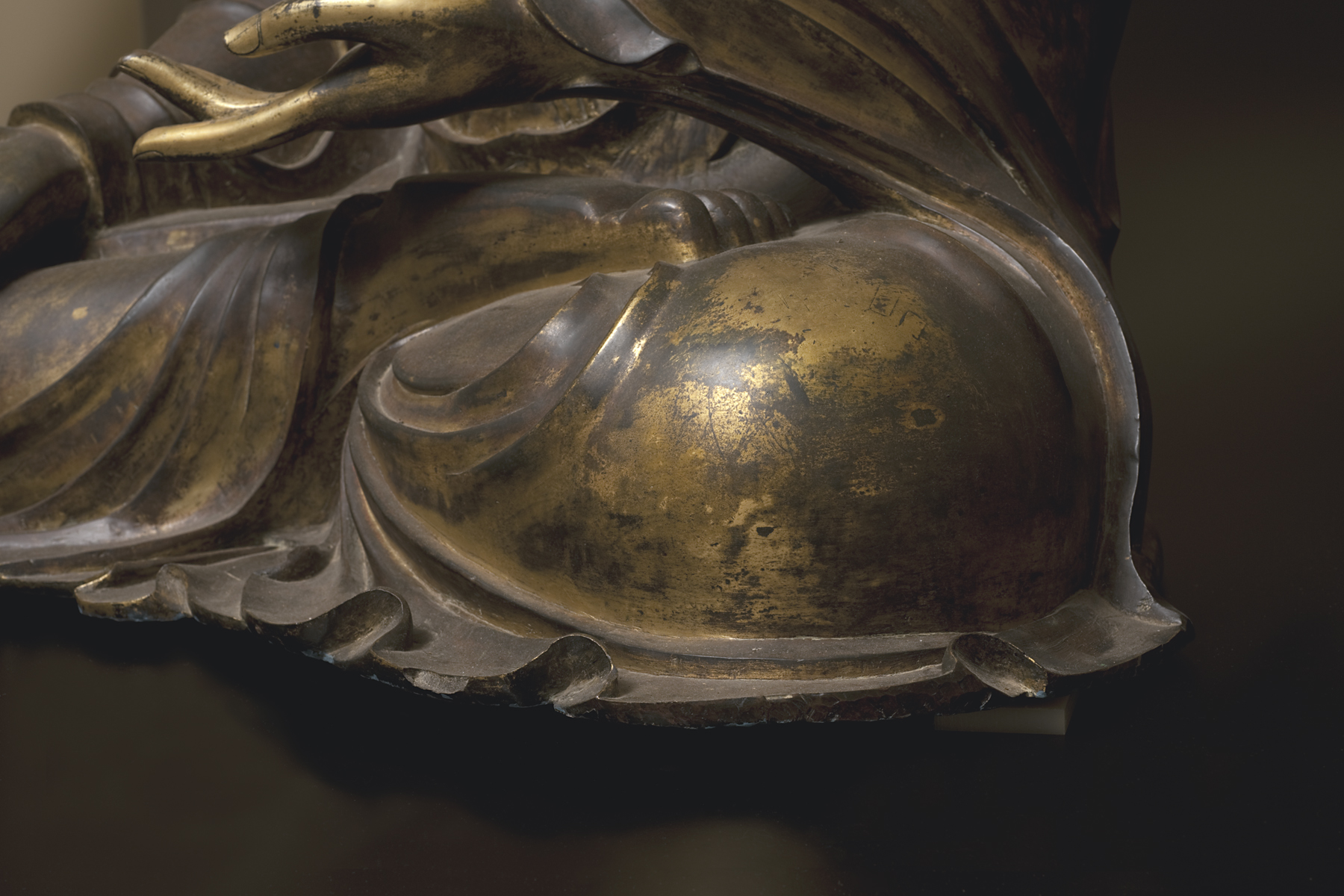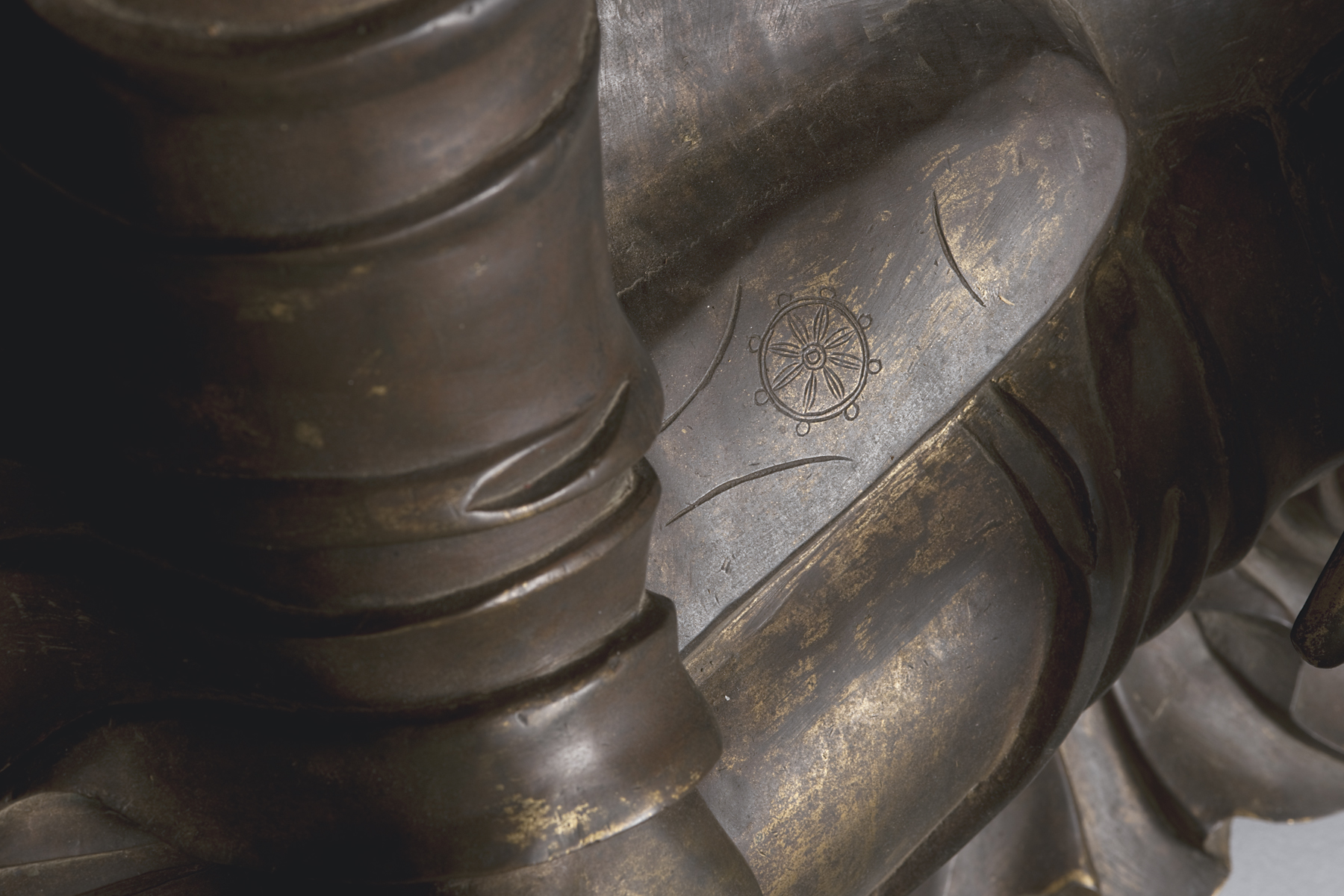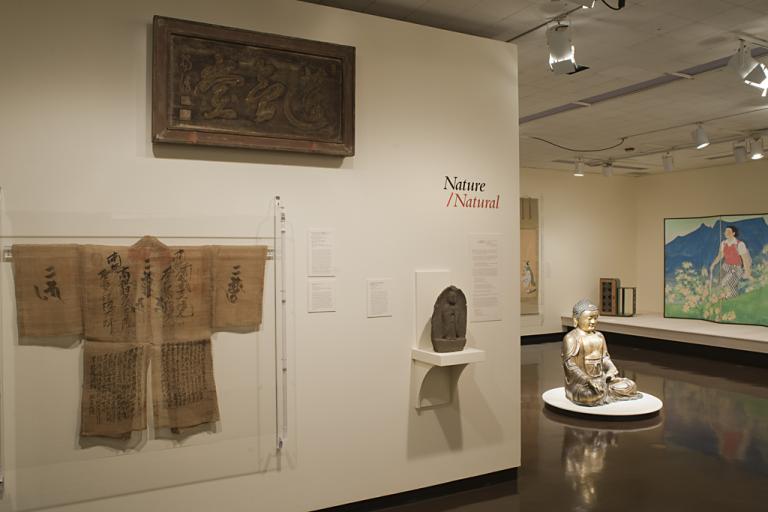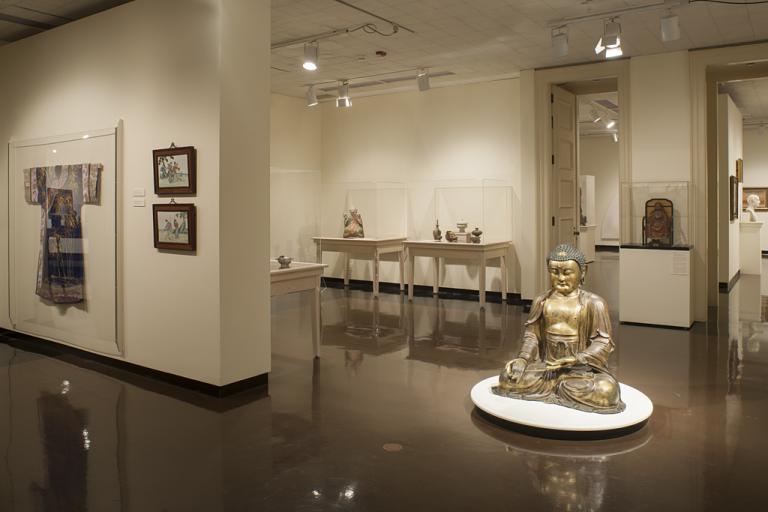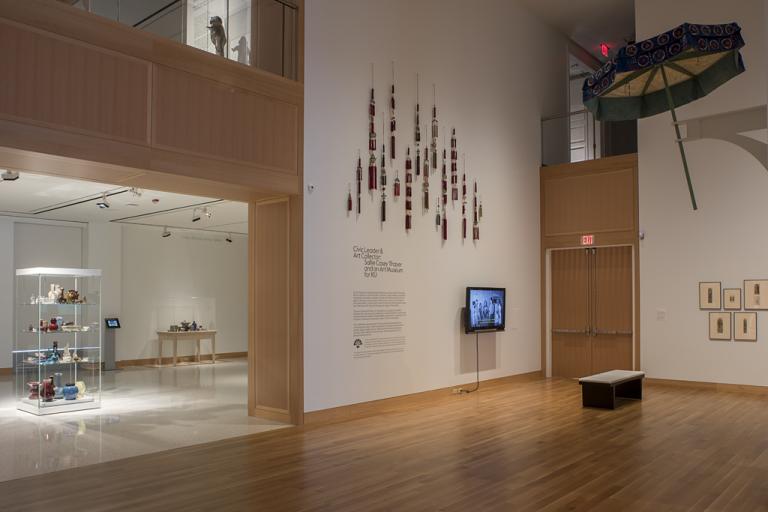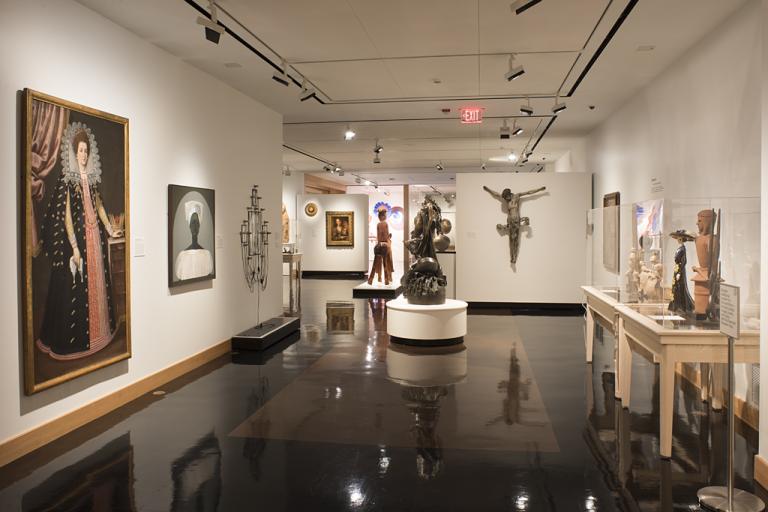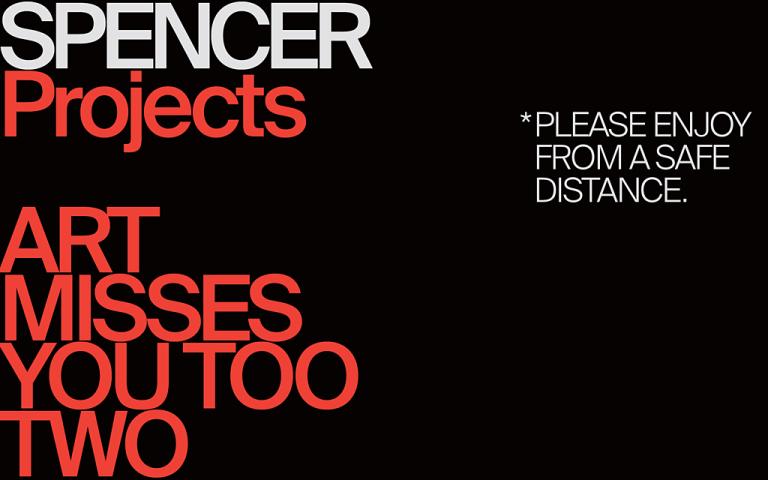藥師佛 Yaoshi fo (Medicine Buddha), unknown maker from China
Artwork Overview

Object Height/Width/Depth (Height x Width x Depth): 104 x 90 x 61 cm
Object Height/Width/Depth (Height x Width x Depth): 40 15/16 x 35 7/16 x 24 in
If you wish to reproduce this image, please submit an image request
Images
Label texts
This sculpture of the Medicine Buddha holds a myrobolan fruit in its right hand. This fruit is a symbol of healing and medicine that can be found in India, Nepal, Sri Lanka, and southwestern China. It is also called a “medicine pill,” because it can help with digestive issues.
If you know any medicinal or healing plants, name them. What do they help heal?
What else about this sculpture might suggest healing to you?
This cast-bronze, gilded Buddha is known as Bhaisajyaguru or Medicine Buddha, who is associated with healing and medicine. In the 7th century, the Chinese monk Yijing (635–713) traveled to India and translated into Chinese the Sanskrit scripture Bhaisajyaguru Sutra—a major textual source for understanding the Medicine Buddha. Since that time, worship of Medicine Buddha has expanded enormously in China.
This cast-bronze gilded Buddha, known as Bhaisajyaguru or Medicine Buddha, is associated with healing and medicine. During the seventh century, the Chinese monk Yijing (635 CE–713 CE) traveled to India and translated the Bhaisajyaguru Sutra from Sanskrit to Chinese. This was an important text for understanding the Medicine Buddha. Since then, worship of the Medicine Buddha has expanded across China.
This cast-bronze gilded Buddha, known as Bhaisajyaguru or Medicine Buddha, is associated with healing and medicine. During the seventh century, the Chinese monk Yijing (635 CE–713 CE) traveled to India and translated the Bhaisajyaguru Sutra from Sanskrit to Chinese. This was an important text for understanding the Medicine Buddha. Since then, worship of the Medicine Buddha has expanded across China.
This representation of the Medicine Buddha includes details that reflect Buddhist beliefs. Etched on his right foot is the dharmachakra, an eight-spoked wheel symbolizing the Buddha’s teachings. In the center of his forehead is the third eye, one of the “Thirty-Two Attributes of a Great Man” that the Buddha is said to possess. Earlobes stretched by heavy jewelry worn in his youth as a prince symbolize a conscious rejection of the material world in favor of spiritual enlightenment.
This bronze sculpture was purchased in 1920 by Sallie Casey Thayer as part of her founding gift that established an art museum at the University of Kansas. Research on the sculpture’s provenance—the history of an object’s ownership, location, or custody—suggests it was once displayed with two companions: Sakyamuni (the historical Buddha) and Amitabha (the Buddha of the Western Paradise), which are now displayed in the Abby Aldrich Rockefeller Garden in Seal Garden, Maine, United States.
This cast-bronze gilded Buddha, known as Bhaisajyaguru or Medicine Buddha, is associated with healing and medicine. During the seventh century, the Chinese monk Yijing (635 CE–713 CE) traveled to India and translated the Bhaisajyaguru Sutra from Sanskrit to Chinese. This was an important text for understanding the Medicine Buddha. Since then, worship of the Medicine Buddha has expanded across China.
This representation of the Medicine Buddha includes details that reflect Buddhist beliefs. Etched on his right foot is the dharmachakra, an eight-spoked wheel symbolizing the Buddha’s teachings. In the center of his forehead is the third eye, one of the “Thirty-Two Attributes of a Great Man” that the Buddha is said to possess. Earlobes stretched by heavy jewelry worn in his youth as a prince symbolize a conscious rejection of the material world in favor of spiritual enlightenment.
This cast-bronze gilded sculpture represents the Buddha associated with healing and medicine. The Medicine Buddha is seated in a meditation pose and holds a myrobalan fruit in his right hand. This fruit is native to India, Nepal, Sri Lanka, and southwestern China, and is frequently used in traditional medicine. Other representations of the Medicine Buddha sometimes include a medicine pot or bowl in his left hand.
This Medicine Buddha may have originally been a part of a sculptural triad. The other two sculptures, identified as Sakyamuni (the historical Buddha) and Amitabha (the Buddha of the Western Paradise), are now located in the Abby Aldrich Rockefeller Garden in Maine. In the Mahayana tradition of Buddhism, Sakyamuni, Amitabha, and the Medicine Buddha represent the founder, consoler, and healer.
This cast-bronze gilded sculpture represents the Buddha associated with healing and medicine. The Medicine Buddha is seated in a meditation pose and holds a myrobalan fruit in his right hand. This fruit is native to India, Nepal, Sri Lanka, and southwestern China, and is frequently used in traditional medicine. Other representations of the Medicine Buddha sometimes include a medicine pot or bowl in his left hand.
This Medicine Buddha may have originally been a part of a sculptural triad. The other two sculptures, identified as Sakyamuni (the historical Buddha) and Amitabha (the Buddha of the Western Paradise), are now located in the Abby Aldrich Rockefeller Garden in Maine. In the Mahayana tradition of Buddhism, Sakyamuni, Amitabha, and the Medicine Buddha represent the founder, consoler, and healer.
This representation of the Medicine Buddha can be identified by the fruit he holds in his left hand. The myrobalan (Terminalia chebula) is a small fruit found in South Asia that has long been revered for its healing properties. A seventh-century sutra, or teaching, recounts the twelve vows the Medicine Buddha made to help living beings after he attained enlightenment, including alleviating pain and disabilities, curing disease, and promoting optimal health. Since then, people have meditated with the mantra of the Medicine Buddha to overcome sickness and ease suffering for themselves or others. Meditation with this mantra is believed to purify the underlying karmic causes of diseases and cultivate holistic well-being. Meditation in general offers many health benefits, including the production of immune-boosting endorphins.
This representation of the Medicine Buddha can be identified by the fruit he holds in his left hand. The myrobalan (Terminalia chebula) is a small fruit found in South Asia that has long been revered for its healing properties. A seventh-century sutra, or teaching, recounts the twelve vows the Medicine Buddha made to help living beings after he attained enlightenment, including alleviating pain and disabilities, curing disease, and promoting optimal health. Since then, people have meditated with the mantra of the Medicine Buddha to overcome sickness and ease suffering for themselves or others. Meditation with this mantra is believed to purify the underlying karmic causes of diseases and cultivate holistic well-being. Meditation in general offers many health benefits, including the production of immune-boosting endorphins.
Continue your path to serenity by viewing the Medicine Buddha. This particular Buddha is associated with healing and medicine. In its right hand is a myrobolan fruit, also called a “medicine pill” because it can help with digestive issues. People have been meditating in front of this tranquil bronze sculpture for centuries. Feel free to give it a try. Be still and focus. Take all the time you like.
This cast-bronze, gilded Buddha, known as Bhaisajyaguru or Medicine Buddha, is associated with healing and medicine. During the seventh century, the Chinese monk Yijing (635 CE–713 CE) traveled to India and translated the Bhaisajyaguru Sutra from Sanskrit into Chinese. This was an important textual source for understanding the Medicine Buddha, and since that time worship of the Medicine Buddha has expanded enormously in China.
When Sallie Casey Thayer purchased this Buddha from the Japanese art dealer Yamanaka in 1920, it may have been a part of a sculptural triad. The other two sculptures, identified as Sakyamuni (the historical Buddha) and Amitabha (the Buddha of the Western Paradise), are now located in the Abby Aldrich Rockefeller Garden in Maine. In the Mahayana (Great Vehicle) tradition of Buddhism, Sakyamuni, Amitabha, and the Medicine Buddha stand supreme, representing the founder, consoler, and healer. This sculptural assemblage of three Buddhas is commonly found on the principal altar of the main assembly hall in Chinese Buddhist temples; however, the original location of this triad remains unknown.
This cast-bronze, gilded Buddha, known as Bhaisajyaguru or Medicine Buddha, is associated with healing and medicine. During the seventh century, the Chinese monk Yijing (635 CE–713 CE) traveled to India and translated the Bhaisajyaguru Sutra from Sanskrit into Chinese. This was an important textual source for understanding the Medicine Buddha, and since that time worship
of the Medicine Buddha has expanded enormously in China.
When Sallie Casey Thayer purchased this Buddha from the Japanese art dealer Yamanaka in 1920, it may have been a part of a sculptural triad. The other two sculptures, identified as Sakyamuni (the historical Buddha) and Amitabha (the Buddha
of the Western Paradise), are now located in the Abby Aldrich Rockefeller Garden in Maine. In the Mahayana (Great Vehicle) tradition of Buddhism, Sakyamuni, Amitabha, and the Medicine Buddha stand supreme, representing the founder, consoler, and
healer. This sculptural assemblage of three Buddhas is commonly found on the principal altar of the main assembly hall in Chinese Buddhist temples; however, the original location of this triad remains unknown.This sculpture depicts the Medicine Buddha seated in a meditation pose, holding a myrobalan fruit, also known as the healing aruna fruit, in his right hand. This fruit is native to India, Nepal, Sri Lanka, and southwestern China. It is commonly referred to as a “medicine pill” in oral tradition for its healing properties. Other representations of the Medicine Buddha sometimes show the deity with a medicine pot or bowl in his left hand.
Tap on the Web icon above and click on the links to view the Buddhas in Rockefeller’s Maine garden.
Tap on the Web icon above and click on the link to view a painted representation of The Eight Medicine Buddhas from 18th-century Tibet in the collection of the Freer Gallery of Art. This sculpture shows the Buddha holding a medicine pot.
Tap on the Web icon above and click on the link to view a standing gilt bronze representation of Buddha Bhaisajyaguru from sixth-century China, also in the collection of the Freer Gallery of Art.
Tap the Audio icon above to hear a Southwest Middle School student’s perspective of the sculpture.
Tap the image above and swipe to view details of the Buddha
Continue your path to serenity by viewing the Medicine Buddha. This particular Buddha is associated with healing and medicine holds a myrobolan fruit in its right hand. A myrobolan is also called a “medicine pill,” because it can help with digestive issues. People have been meditating in front of this tranquil bronze sculpture for centuries. Feel free to give it a try. Be still and focus. Take all the time you like.
This cast-bronze gilded Buddha is known as Bhaisajyaguru in Sanskrit, or the Medicine Buddha, and is associated with healing. He is seated in a meditation pose holding a myrobalan, or healing aruna fruit, in his right hand. Buddhists recite the mantra of the Medicine Buddha to overcome sickness and ease suffering.
This cast-bronze, gilded Buddha is known as Bhaisajyaguru or Medicine Buddha, who is associated with healing and medicine. In the 7th century, the Chinese monk Yijing (635–713), traveled to India and translated into Chinese the Sanskrit scripture Bhaisajyaguru Sutra, which was an important textual source for understanding the Medicine Buddha. Since that time, worship of Medicine Buddha has expanded enormously in China.
When Sallie Casey Thayer purchased this Medicine Buddha from the Japanese art dealer Yamanaka in 1920, it may have been a part of a sculptural triad. The other two, identified as Sakyamuni (the historical Buddha) and Amitabha (the Buddha of the Western Paradise) are now located in the Abby Aldrich Rockefeller Garden in Maine. In the Mahayana (Great Vehicle) tradition of Buddhism, Sakyamuni, Amitabha, and the Medicine Buddha stand supreme, respectively representing the founder, consoler, and healer. This sculptural assemblage of three Buddhas is commonly found on the principal altar of the main assembly hall in Chinese Buddhist temples; however, the original location of this triad remains unknown.
This sculpture depicts the Medicine Buddha seated in the meditation pose, holding a myrobalan fruit or healing aruna fruit in his right hand. This fruit is native to India, Nepal, Sri Lanka, and southwestern China, and is commonly referred to as a “medicine pill” in oral tradition for its healing properties. Other representations of the Medicine Buddha sometimes show the deity with a medicine pot or bowl in his left hand.
Tap on the Web icon above and click on a link to view a painted representation of The Eight Medicine Buddhas from 18th-century Tibet, in the collection of the Freer Gallery of Art, shows the Buddha holding a medicine pot.
Tap on the Web icon above and click on a link to view a standing gilt bronze representation of Buddha Bhaisajyaguru from sixth century China, also in the collection of the Freer Gallery of Art.
Tap the Audio icon above and clink on the link to hear a Southwest Middle School student’s perspective.
Tap the image to view details of the Buddha.
This cast-bronze, gilded Buddha is known as Bhaisajyaguru or Medicine Buddha, who is associated with healing and medicine. In the 7th century, the Chinese monk Yijing (635–713) traveled to India and translated into Chinese the Sanskrit scripture Bhaisajyaguru Sutra—a major textual source for understanding the Medicine Buddha. Since that time, worship of Medicine Buddha has expanded enormously in China.
This cast-bronze, gilded Buddha is known as Bhaisajyaguru or Medicine Buddha, who is associated with healing and medicine. In the 7th century, the Chinese monk Yijing (635-713), traveled to India and translated into Chinese the Sanskrit scripture Bhaisajyaguru Sutra-a major textual source for understanding the Medicine Buddha. Since that time, worship of Medicine Buddha has expanded enormously in China.
Here, the Medicine Buddha seated in the meditation pose holds a myrobalan fruit or healing aruna fruit in his right hand. This fruit is native to India, Nepal, Sri Lanka, and southwestern China, and is referred to as a “medicine pill” in oral tradition. Other representations of the Medicine Buddha sometimes show the deity with a medicine pot or bowl in his left hand.
When Sallie Casey Thayer purchased this Medicine Buddha from the dealer Yamanaka in 1920, it may have been a part of a sculptural triad. The other two, identified as Sakyamuni (the historical Buddha) and Amitabha (the Buddha of the Western Paradise) are now located in the Abby Aldrich Rockefeller Garden in Maine. In the Mahayana (Great Vehicle) tradition of Buddhism, Sakyamuni, Amitabha, and the Medicine Buddha stand supreme, respectively representing the founder, consoler, and healer. This sculptural assemblage of three Buddhas is commonly found on the principal altar of the main assembly hall in Chinese Buddhist temples; however, the original location of this triad remains unknown.
This cast-bronze, gilded Buddha is known as Bhaisajyaguru or Medicine Buddha, who is associated with healing and medicine. In the 7th century, the Chinese monk Yijing (635-713), traveled to India and translated into Chinese the Sanskrit scripture Bhaisajyaguru Sutra-a major textual source for understanding the Medicine Buddha. Since that time, worship of Medicine Buddha has expanded enormously in China.
Here, the Medicine Buddha seated in the meditation pose holds a myrobalan fruit or healing aruna fruit in his right hand. This fruit is native to India, Nepal, Sri Lanka, and southwestern China, and is referred to as a “medicine pill” in oral tradition. Other representations of the Medicine Buddha sometimes show the deity with a medicine pot or bowl in his left hand.
When Sallie Casey Thayer purchased this Medicine Buddha from the dealer Yamanaka in 1920, it may have been a part of a sculptural triad. The other two, identified as Sakyamuni (the historical Buddha) and Amitabha (the Buddha of the Western Paradise) are now located in the Abby Aldrich Rockefeller Garden in Maine. In the Mahayana (Great Vehicle) tradition of Buddhism, Sakyamuni, Amitabha, and the Medicine Buddha stand supreme, respectively representing the founder, consoler, and healer. This sculptural assemblage of three Buddhas is commonly found on the principal altar of the main assembly hall in Chinese Buddhist temples; however, the original location of this triad remains unknown.
This cast-bronze, gilded Buddha is known as Bhaisajyaguru or Medicine Buddha, who is associated with healing and medicine. In the 7th century, the Chinese monk Yijing (635-713), traveled to India and translated into Chinese the Sanskrit scripture Bhaisajyaguru Sutra-a major textual source for understanding the Medicine Buddha. Since that time, worship of Medicine Buddha has expanded enormously in China.
Here, the Medicine Buddha seated in the meditation pose holds a myrobalan fruit or healing aruna fruit in his right hand. This fruit is native to India, Nepal, Sri Lanka, and southwestern China, and is referred to as a “medicine pill” in oral tradition. Other representations of the Medicine Buddha sometimes show the deity with a medicine pot or bowl in his left hand.
When Sallie Casey Thayer purchased this Medicine Buddha from the dealer Yamanaka in 1920, it may have been a part of a sculptural triad. The other two, identified as Sakyamuni (the historical Buddha) and Amitabha (the Buddha of the Western Paradise) are now located in the Abby Aldrich Rockefeller Garden in Maine. In the Mahayana (Great Vehicle) tradition of Buddhism, Sakyamuni, Amitabha, and the Medicine Buddha stand supreme, respectively representing the founder, consoler, and healer. This sculptural assemblage of three Buddhas is commonly found on the principal altar of the main assembly hall in Chinese Buddhist temples; however, the original location of this triad remains unknown.
Exhibition Label:
"Nature/Natural," Feb-2011, Kris Ercums
As Buddhism developed during the Ming dynasty, especially under the so-called Wanli revival (1563-1620), it coalesced into a pervasive religious force that formed a pivotal role in the everyday life of the Chinese. Holding a jewel in his right hand, this cast-bronze, gilded Buddha is known as Ratnasambhava, who is associated with wealth and giving. As one of the “Five Meditation Buddhas,” Ratnasambhava is an important part of Vajrayana or Tantric practice, an esoteric form of Buddhism that gained popularity during the Ming period.
Exhibitions
Kate Meyer, curator
Celka Straughn, curator
Kate Meyer, curator
Celka Straughn, curator
